Facilities
-
In This Section
The Sis and Herman Dupré Science Pavilion
The Sis and Herman Dupré Science Pavilion is the home to The Herbert W. Boyer School of Natural Sciences, Mathematics and Computing. This unique, 113,260 square foot pavilion supports the school in its effort to offer undergraduate and graduate students a rigorous, integrated curriculum grounded in the sciences and the Catholic, Benedictine tradition. The pavilion's first four buildings had renovation and new construction between 2010-2013 that comprised 102,000 square feet. In 2017 the James F. Will Engineering and Biomedical Sciences Hall added 11,260 square feet of space to the pavilion. These principles create an environment for study characterized by mutual respect, personal attention and open dialogue.
Inside the pavilion, to support the Boyer School, you will also find:
- The Angelo Taiani Planetarium and Astronaut Exhibit
- The Dr. Frank J. Luparello Lecture Hall
- The Digital Imaging Lab
- The Ralph Liberatore Human Anatomy Lab
Outside the pavilion, and a short walk, you will find:
- Winnie Palmer Nature Reserve (WPNR)
The Sis and Herman Dupré Science Pavilion at Saint Vincent College is more than just a building. It's a symbol of the school's commitment to science education. I am particularly impressed by the facility's innovative design elements -- inspired by science and math themes -- alongside its multi-use labs where different sciences can cross-pollinate their methods, tools, and ideas toward a greater understanding of the physical world.
Neil deGrasse Tyson, Astrophysicist
The Herbert W. Boyer School of Natural Sciences, Mathematics and Computing
-
Planetarium
Angelo J. Taiani Planetarium and Astronaut Exhibit
Saint Vincent College is proud to host the Angelo J. Taiani Planetarium and Astronaut Exhibit in the Sis and Herman Dupré Science Pavilion, where public planetarium shows are scheduled. Shows are conducted by astronomer Dr. Dan Vanden Berk of the College’s Department of Physics, and trained student assistants
All shows are free of charge. Public shows are scheduled on a seasonal basis, and listed below. Private shows can be scheduled for groups of up to 35 people. We are happy to welcome school, church, scouting, and other groups for shows. Reservations may be made by calling the Herbert W. Boyer School of Natural Science, Mathematics, and Computing at 724-805-2631, Monday through Friday from 8:30 a.m. to 4:30 p.m.
Saint Vincent College will host The Star of Bethlehem planetarium shows at the Taiani Planetarium in the Dupré Science Pavilion, on Wednesday, Dec. 10, at 7 p.m., and Saturday, Dec. 13 at 4 p.m. All shows are free of charge, but seating is limited. For reservations or questions, please contact Erin Black at 724-805-2631, or erin.black@stvincent.edu
-
The Dr. Frank J. Luparello Lecture Hall
The Dr. Frank Luparello Lecture Hall pays tribute to an outstanding teacher and physician, the late Dr. Frank Luparello, C'49. Dr. Luparello's illustrious medical career spanned more than 50 years, which all began with the Benedictine teachers he had as an undergraduate pre-med student at Saint Vincent. -
Digital Imaging Lab
A Centralized Facility for Digital Imaging, Analysis, and Quantitation
The Digital Imaging Lab (DIL) is supported by a National Science Foundation Course Curriculum and Laboratory Improvement Grant #0510230 and Saint Vincent College
The Digital Imaging Lab is utilized by faculty and students throughout the natural science curriculum for inquiry-based classroom and/or laboratory-based activities and for faculty and student research projects.
The DIL occupies rooms 207 and 208 in the biology building. Room 207 houses the Molecular Imager and Multidetection Microtiter Plate Reader, while room 208 houses the Microscopy Suite, which is equipped with student and instructor stations for imaging with four types of microscopy.
Equipment
Microscopy Suite
The DIL facility consists of eight student microscopy stations, one instructor station, and a molecular imaging station, each with image acquisition and analysis capability. In all, there are thirteen microscopes, representing four types of optical microscopy (compound, inverted, stereo, and polarizing).Student Stations
Each of the eight student stations are outfitted with modified Olympus CX41 upright microscopes with capacity for bright field, phase contrast, dark field, and three-color fluorescence microscopy. All eight microscopes are equipped with a dedicated 5 megapixel Olympus Q-color 5 cooled color digital camera connected to a PC loaded with four types of image analysis software.Instructor Station
The instructor station contains two microscopes, an Olympus BX-51 research-grade upright microscope with bright field, dark field, fluorescence, and differential interference contrast (DIC) capabilities, and an Olympus IX51 research-grade inverted microscope with phase contrast and fluorescence functionalities for cell culture work. A PC-connected 12.1 megapixel Olympus DP70 megapixel cooled color camera resident at the station can be mounted to either scope.Additional Microscopes
The facility also contains two Olympus SZX-9 student/research grade dissection microscopes that can be readily connected to any of the camera-PC combinations and one Olympus CX-31 Pol student-grade polarizing microscope with a 360° stage for examination of thin sections of minerals and amyloid bundles in prion-containing yeast cells and cultured neurons.Projection
An Epson 3000 lumens wireless digital projector projects images from the various stages for group viewing.Molecular Imager
A Fuji LAS-3000 molecular imager used to digitize and quantitatively analyze 1-D and 2-D protein gels, nucleic acid gels, and fluorescent or chemiluminescent protein or nucleic acid blots.Microtiter Plate Reader
A Biotek Synergy HT multi-detection microtiter plate reader with capabilities for absorbance monitoring between 200-1000 nm, fluorescence (top or bottom read), time-resolved fluorescence, luminescence, sample injection, incubation and shaking is used to quantify reactions or assays in 6-384 well plates. -
The Liberatore Human Anatomy Lab
The centerpiece of the James F. Will Hall is the Ralph H. Liberatore Human Anatomy Suite, an expansive, state-of -the-art laboratory space suitable for medical training sessions for physicians and surgeons. The laboratory is equipped with six surgical stations for anatomical research. In addition to supporting our growing programs in the health sciences, the lab will be available for use by physicians, health care agencies and medical device companies for surgical training sessions, continuing medical education and research. The facility features advanced audio and video capabilities, including a teaching station equipped with cameras and multiple monitors to enhance instruction. Support facilities for the human anatomy laboratory include a technologically-equipped conference room, a lab preparation space, a refrigerated storage area and spacious locker and changing rooms. We have the equipment and facilities to suit our clients’ diverse needs.
-
Winnie Palmer Nature Reserve
The Winnie Palmer Nature Reserve provide students with outdoor laboratories and places on campus to relax in a natural setting.
-
Machine Shop
S-104The Machine Shop is equipped with a 10” lathe, two small milling machines, drill presses and various other tools for small to medium machining operations for research and Capstone Projects.
-
Synthetic Chemistry Lab
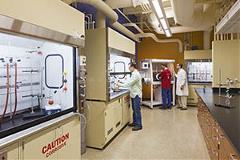 S-205
S-205
Used by senior research students in chemistry as well as for courses such as Advanced Chemical Methods, this lab is equipped with 3 Schlenk lines for airfree chemical syntheses as well as a Mbraun inert atmosphere glovebox, which allows our faculty and students to work in an atmosphere that facilitates their work with materials that are sensitive to water and oxygen. Again, most schools our size don’t have this type of equipment. These will be found in industry or graduate research institutions. It allows a harder synthesis. It is like trying to make something that is sensitive to oxygen easier to work there. It uses an argon atmosphere to keep oxygen and moisture out.
A grant from the George I. Alden Trust
-
Microbiology/Biochemistry Lab
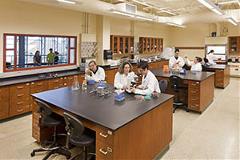 S-211
S-211
The Microbiology/Biochemistry Lab is a cross-discipline laboratory is set up with both a chemical and a biology hood and gas at all stations for the teaching of Microbiology and Biochemistry courses.
-
Advanced Chemistry Lab
 S-212
S-212
Used by senior research students in chemistry as well as for upper level chemistry courses such as Quantitative Analysis and Advanced Physical Method. The lab is equipped with a vacuum line and a Parr Bomb Calorimeter.
-
Cell and Molecular Biology Lab
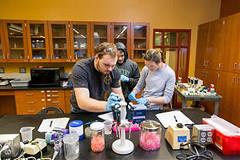 S-213
S-213
The Cell & Molecular Biology Lab is used by sophomore-level Cell Biology and upper-level courses including Developmental Biology, Molecular Genetics and Biotechnology.
A Gift of Fr. Edward Wenstrup, O.S.B.
-
Cell Culture Lab
 S-215
S-215
Equipped with multiple biological hoods and a double-door entry, this laboratory is used for cell culture for cell biology, molecular biology and biotechnology along with senior research in biology and biochemistry.
A Gift of the Eden Hall Foundation
-
Organic Chemistry Lab

S-222
This lab is used for organic chemistry lab sequence.
A Gift of Fr. Bertin Etling, O.S.B.
-
Physiology & Pharmacology Research Lab
 N-103
N-103
The Physiology & Pharmacology Research Lab is used by senior research students in biology especially in the areas of stress physiology and pharmacology.
A Gift of the Allegheny Foundation
-
Ornithology & Organism Research Lab
 N-105
N-105
The Ornithology & Organism Research Lab is used by senior research students in biology, especially in the areas of ornithology and whole organism research.
A Gift of the SV Preparatory School Alumni
-
Environmental Research Laboratory
 N-107
N-107
The Environmental Research Laboratory is used by students to undertake a variety of research projects. It houses a range of equipment including:- Two Yellow Spring Instrument (YSI) Pro Plus multimeters for measuring pH, conductivity, dissolved oxygen and temperature in aquatic systems to assess water quality
- 10 YSI 600 sondes that can be deployed to measure pH, conductivity, dissolved oxygen and temperature in aquatic systems to evaluate possible sources of water pollution
- Two YSI 6600 sondes that can be deployed to measure turbidity, chlorophyll a, pH, conductivity, dissolved oxygen and temperature in aquatic systems to examine water quality
- Hach test kits and colorimeters to measure key water and soil parameters including nutrients (nitrate and phosphate), metals (iron, aluminum, zinc, chromium), alkalinity and common ions such as sulfate.
-
Senior Research Lab and Life Science Research Facility
 N-150
N-150
The lab is used by senior research students and faculty in biology, environmental science and psychology. It is part of the Life Sciences Research Facility which includes four animal holding rooms, a cage-washing room, two storage rooms, and a procedure room. It is used by senior research students and faculty members for research projects meeting federal standards of animal care.
A Gift of the SVC Class of 1960
-
Visiting Research Lab

N-161
The Visiting Research Lab is available to be used by senior research students, a visiting instructor or faculty overflow projects.A Gift of the Jendeco Construction Corporation
-
Aquaculture Center
 N-162
N-162
The Aquaculture Center is equipped with breeding aquaria and equipment for zebrafish research.
-
Genetics, Cell and Developmental Research Lab

N-202
The Genetics, Cell and Developmental Research Lab is used by senior research students in biology, especially genetics and developmental biology. The lab is equipped with molecular biology equipment and shaking water baths.A Gift of Dr. & Mr. Ferdinand L. Soisson, Jr.
-
Biological Science Lab
 N-204
N-204
This lab with movable student stations and above-bench electricity is used by non-majors science courses in environmental sciences and biology.
-
Palumbo Research Lab
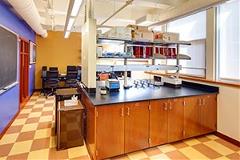 N-205
N-205
Used by senior research students in biology and bioinformatics, this lab is split between a wet-lab space and a dry-lab space with computers.
A Gift of the A.J. and Sigismunda Palumbo Charitable Trust
-
General Biology Lab
 N-206
N-206
The General Biology Lab is used for General Biology 1 and 2 with movable student stations and above-bench electricity.
A Gift of Fr. Owen Roth, O.S.B.
-
Biochemistry and Microbiology Research lab
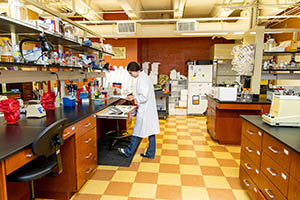 N-214
N-214
Used by senior research students in both biology and biochemistry, the lab is equipped with a both a chemical and a biological fume hood along with multiple gas jets for aseptic technique work. Multiple pieces of molecular equipment are present.
A Gift of Charles and Shirley Varsel
-
Evelyn & Batista Madonia, Sr. Environmental Center and Greenhouse
The greenhouse contains 454 square feet of plant shelving divided between two rooms. The climate of each room can be controlled individually using a computer interface that automatically adjusts roof shades, lighting, heat, air circulation, cooling fans and humidity via an advanced misting system. The greenhouse is used for growing plants for the Saint Vincent community along with classes in biology. In addition, senior research students from biology and environmental science utilize this space for botany and animal research. -
General Physics Lab
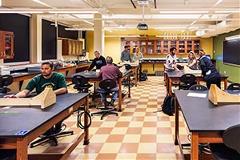 E-109
E-109General-purpose laboratory used for General Physics, Introduction to Physics and other physics courses for non-science majors.
Fr. Roland Heid, O.S.B. - Gift of Jim and Mary Ellen Will
-
Analytical & Physical Research Lab
E-202The Analytical & Physical Research Lab is used primarily for physical chemistry teaching and research. It is equipped with a wide variety of light sources, lasers, spectrometers, oscilloscopes and other electronic devices to investigate physical chemistry phenomena. Students have used this lab to study techniques such as photocatalysis and nanoparticle synthesis, which can be used to benefit environmental and biological systems.
A Gift of the United States Steel Corporation
-
Instrument Lab
E-206This facility houses the instrumentation for the chemistry department and is used by our analytical chemistry courses. One of the things that we are proud to say is that we have a rich array of instruments and our students get to use them. We have an array of instruments such as they would see in a graduate research lab or in an industrial lab. Our instruments may not be of the same size or have the precision that you might find in industry or in a graduate research institution but they operate under the same principles. Our students have hands-on training and experiences with them, and they can then go out and use them in industrial labs or in graduate research labs. One thing we are proud to say about the Instrument Laboratory and our chemistry program in general is that they are set up for students to learn to use the instruments and to learn how to troubleshoot them. This is in contrast or opposed to handing the solutions to a laboratory technician who will then run the sample and give the results back. This hands-on experience gives our students a leg up in having a variety of experiences with instruments. Among the instruments in this lab are the ion chromatograph (IC) and Gas Chromatography Mass spectrometer (GC Mass Spec). These are used to separate and identify components in a mixture.
A Gift of the Kennametal Foundation
-
General Chemistry Lab
 E-208
E-208This lab serves the General Chemistry Lab sequence exclusively.
-
Physical and Chemical Science Lab
 E-217
E-217The Physical and Chemical Science Lab is used for nonmajors labs in chemistry, in areas such as:
- Chemistry of Cooking
- Chemistry of Crime
- Chemistry of Art
- Chemistry of Daily Life
-
Physics Research Lab
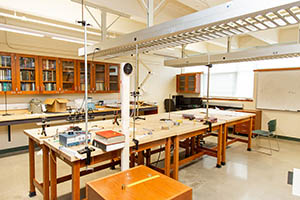 W-103The lab is used by physics majors for research and capstone projects.
W-103The lab is used by physics majors for research and capstone projects.A Gift of Joseph P. Rich
-
Electronics Lab
 W-104
W-104The Electronics Lab has equipment for fabricating printed circuit board and soldering surface mount parts. In addition this lab contains several electronics design automation (EDA) stations, digital storage oscilloscopes and various other electronics equipment and parts inventory.
-
Physics Research Lab
 W-105
W-105The Physics Research Lab contains books and journals of all areas of physics and space for physics majors to work collectively or individually.
A Gift of the Very Rev. Paul E. Turnbull
-
Modern Physics Lab
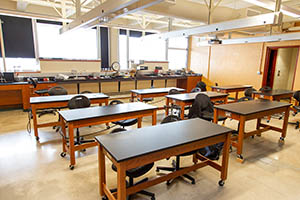 W-106
W-106Used for Modern Physics I, Optics and Advanced Lab, this lab offers various modern physics related experiments, including:
- Franck-Hertz experiment (to verify the quantization of atomic orbitals)
- Geiger counters
- Sodium lamp (to study the split in the spectrum lines and its relation to the uncertainty principle)
There is also holography equipment used to make holograms. The lab also contains various other optical equipment and a dark room.
-
Peterson Computer Workroom
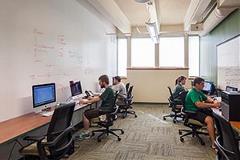 W-210
W-210The Peterson Computer Workroom has both PCs and Macs and is used primarily for software projects and occasionally, for IT and Cybersecurity projects.
A Gift of Lois E. Gallagher
-
General Computing Lab
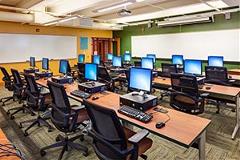 WG-02
WG-02The General Computing Lab houses 24 desktop computers loaded with various computer programs used by Boyer School majors plus 2 printers.
The following courses are taught in this lab:
- Engineering Graphics and Design
- Biomedical Informatics
- Intro to Geo Info Systems
The lab is also open to students for working on assignments and as study space.
-
Engineering Design Lab
JFW-205This lab, used for Materials Laboratory, Engineering Design Laboratory and for special projects, is well-equipped with microscopes, hardness testers, a furnace, metallographic specimen prep tools and 3D printers for polymers.
-
Observatory
-
Stephans Computer Modeling Lab
JFW-207The Stephans Computer Modeling Lab houses 13 PC workstations used for data analysis and special projects.
A Gift of Peter N. and Joan R. Stephans and the Rossin Foundation
